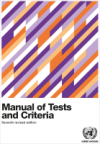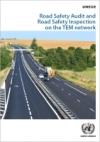Publications
Displaying Results 41 - 60 of 192
- English
The UN Road Safety Fund’s (UNRSF) secretariat seeks additional financial support from private and public sector donors where the Fund’s mission and donor priorities are aligned. Read more in the UNRSF donor brochure to consider becoming a donor.
Contact the UNRSF secretariat for more information at unrsf_secretariat
- English
The UNRSF 2019 Annual Report is now available. Established two years ago as an innovative United Nations pooled fund, the Annual Report showcases the first concrete results of the UNRSF and thus demonstrates its potential to meet its ambition to substantially reduce death and injuries from road crashes in low and middle-income countries where 93% of the world fatalities occur.
- English
Organizations around the world are quickly adapting their programme and project activities to respond to the COVID-19 pandemic and its consequences. The UN Road Safety Fund is committed to the principles of adaptive programming, partnerships, and relevance. The operationalization of these principles is even more critical during this unparalleled time. This flyer provides tools and tips for
- English
This study, commissioned by the Steering Committee of the Transport, Health and Environment PanEuropean Programme (THE PEP) through its Partnership on Jobs in Green and Healthy Transport, examines the economy-wide employment implications of an accelerated shift towards greener land
- English
The April 2020 marks the second anniversary of the launch of the United Nations Road Safety Fund (UNRSF). The Fund is now financing 15 projects in 20 low- and middle-income countries to substantially reduce death and injuries from road crashes and to reduce economic losses resulting from these crashes.
- English
ECE/TRANS/290,
Sales No. E.20.VIII.2,
ISBN 978-92-1-117241-6,
Price: US$ 35,
Languages: E, F, R
The Agreement on the International Carriage of Perishable Foodstuffs and on the Special Equipment to be Used for such Carriage (ATP) was done at Geneva on 1 September 1970 and entered into force on 21 November 1976.
The objectives of the ATP are to facilitate international transport
- English
ST/SG/AC.10/11/Rev.7
Sales No. E.20.VIII.1
ISBN 978-92-1-130394-0
eISBN 978-92-1-004503-2
Languages: E, F, (A, C, R, S forthcoming)
How to order this publication?
This publication is also available online for free (download).
The "Manual of Tests and Criteria" contains criteria, test methods and
- English
These recommendations have been developed in the light of technical progress, the advent of new substances and materials, the exigencies of modern transport systems and, above all, the requirement to ensure the safety of people, property and the environment. They are addressed to governments and international organisations concerned with the regulation of the transport of dangerous goods. The
- English
The GHS addresses classification of chemicals by types of hazard and proposes harmonized hazard communication elements, including labels and safety data sheets. It aims at ensuring that information on physical hazards and toxicity from chemicals be available in order to enhance the protection of human health and the environment during the handling, transport and use of these chemicals.
The GHS
- English
The European Agreement concerning the International Carriage of Dangerous Goods by Inland Waterways (ADN) done at Geneva on 26 May 2000 under the auspices of the United Nations Economic Commission for Europe (UNECE) and the Central Commission for Navigation on the Rhine (CCNR) has been in force since February 2008. The Agreement currently has eighteen Contracting Parties. The Regulations
- English
Adopted on 30 September 1957 in Geneva under the auspices of the United Nations Economic Commission for Europe (UNECE), the ADR entered into force on 29 January 1968. This authoritative Agreement is intended to increase the safety of international transport of dangerous goods by road. Its Annexes A and B contain the technical requirements for road transport, i.e. the conditions under
- English
Brochure on Trans-European Motorways (TEM) ProjectThis brochure gives an overview of the TEM project, its objectives, organization and how to join it.
- English
Road Safety Audit (RSA) and Road Safety Inspection (RSI) are road infrastructure safety management measures which are considered as important engineering tools for improving infrastructure safety. Road safety is frequently discussed at the TEM Steering Committee, which commissioned Road Safety Audit and Road Safety Inspection on the TEM Network report.The
- English
TEM Project Strategic Plan 2017 – 2021 is a roadmap for the implementation of the TEM Project for 2017 – 2021.The Strategic Plan 2017 – 2021 value proposition:The TEM Project aims to support UNECE and the Inland Transport Committee in pursuing the Sustainable Development Goals related to road infrastructure management;TEM Project will interpret and translate the Sustainable Development Goals
- English
Phase 1 of the Highspeed Masterplan for the TER region has now been completed. The study is available here and covers the following areas:- An introduction to, and history of, High Speed Railways- A review of the benefit, political background, best practice and status of high-speed- Review of related work,
- English
ECE/TRANS/271, Sales No. E.17.VIII.2,ISBN 978-92-1-139160-2, Price: US$ 35, Languages: E, F, RThe Agreement on the International Carriage of Perishable Foodstuffs and on the Special Equipment to be Used for such Carriage (ATP) was done at Geneva on 1 September 1970 and entered into force on 21 November 1976. The objectives of
- English
The GHS addresses classification of chemicals by types of hazard and proposes harmonized hazard communication elements, including labels and safety data sheets. It aims at ensuring that information on physical hazards and toxicity from chemicals be available in order to enhance the protection of human health and the environment during the handling, transport and use of these chemicals.The GHS
- English
These recommendations have been developed in the light of technical progress, the advent of new substances and materials, the exigencies of modern transport systems and, above all, the requirement to ensure the safety of people, property and the environment. They are addressed to governments and international organisations concerned with the regulation of the transport of dangerous goods. The
- English
The European Agreement concerning the International Carriage of Dangerous Goods by Inland Waterways (ADN) done at Geneva on 26 May 2000 under the auspices of the United Nations Economic Commission for Europe (UNECE) and the Central Commission for Navigation on the Rhine (CCNR) has been in force since February 2008. The Agreement currently has eighteen Contracting Parties.The Regulations



















